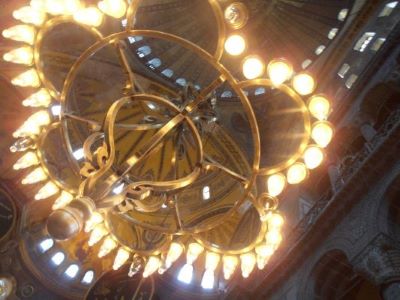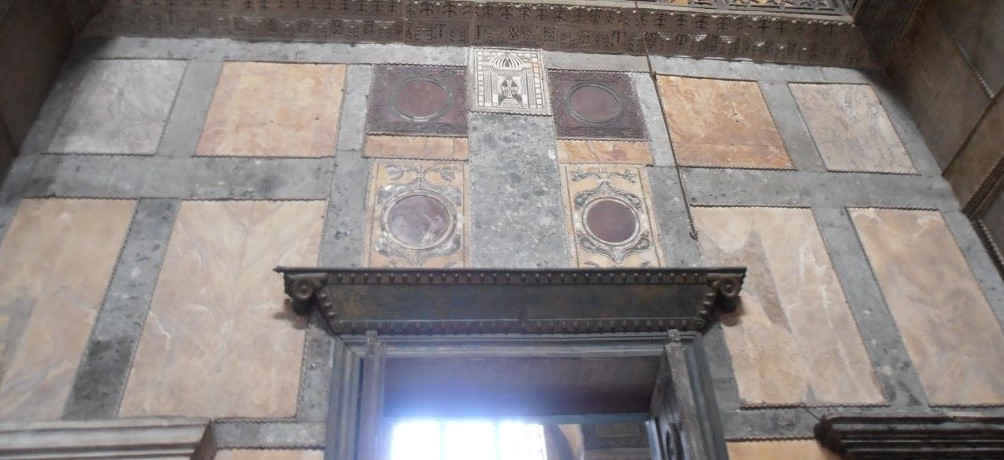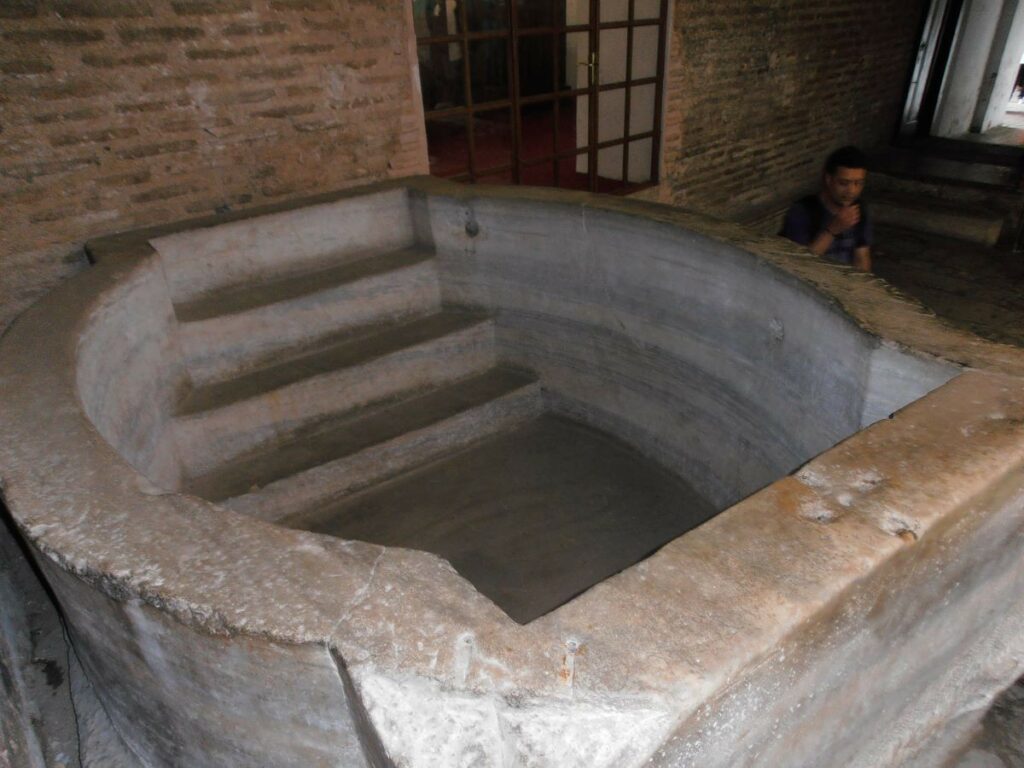Ataturk put the beauty of the Hagia Sophia on exhibition for the world to see, but in 2020, Erdogan repurposed the space to display Islam. As a result, a visit hides multiple Christian sacred items once displayed for touring. This write-up will detail the hidden Christianity that the Hagia Sophia now shuns. In January 2024, the status and entrance of the site changed. Before, the balcony was off-limits, but now the ground floor and courtyard are no longer accessible through a normal entrance.
Previously, I wrote about the items on display in the balcony and the Christian features in the courtyard. Now, let’s look at what is now shunned on a normal visit to the site.
Your visit to the Hagia Sophia will give you an Islamic presentation with the Muslim wooden Arabic panels, an atmosphere of Quranic chanting, and limited access to the main floor. Listed below are a few items now unavailable for a normal tour.
Jesus said I am the Door!
The ancient doorways to the main worship area, presented patterned shadows of former crosses. The doors display former holes or shadowy markings of a former crossbar. Each entry formally featured a cross that non-Christians removed.
The main entry door (seven meters), known as “The Emperor’s Door,” enters the center of the former church. A bronze coating weighs down the door and covers wood many believed to come from Noah’s Ark. Unfortunately, during Ramadan (2022), vandals took pieces out of it for charms.[1]https://www.hurriyetdailynews.com/imperial-gate-in-hagia-sophia-mosque-damaged-173144 The wood on this door is oak, but the Bible says Noah used Gopher wood for the Ark (Gen. 6:14).

Despite the torn horizontal bar, the doors testify that the entrance to the sanctuary came through the cross – reminding believers that entry into God’s presence is by Christ’s death (John 10:9, 14:6).
The five-meter door on the left displayed a cross above and below; centuries ago, the Ottomans removed them.
Before entering through the Emperor’s door, one stares at the one sitting on the exalted throne above. The Lord Jesus, with the Byzantine king, Leo VI, bowing to offer prayers to him. Formerly, the inner central dome had a cross. Similarly, another dome area on the southwest gallery showed Christ seated on his throne surrounded by the Apostles. These existed during the Ottoman mosque up to at least 1850.[2]https://www.pallasweb.com/deesis/drawings-hagia-sophia-loos-grelot.html the 19th-century drawings of the interior give quite a cross-dominated perspective, even after becoming a mosque.

Also, flanked on each side between the other doors demonstrates sacred items to reflect God’s eternality and his unconditional love. The black circles had religious symbols like crosses and doves.[3]https://www.pallasweb.com/deesis/19th-century-hagia-sophia-images-from-getty.html
A Glimpse of Heaven Below
The now carpet covered Muslim prayer area, hides the previous sea-like marble that provided much reflection of light. Before, Byzantine worshipers stood to worship, and likewise, believers today can on their feet pray for the place’s grandeur to speak to hearts continually. Yet, regardless of the rugs, a marble section remains on display – the coronation area of the Byzantine kings (called Omphalion). The beauty reveals the different types of marble used in the construction of the former church. Many historians theorize that these stones display the king’s coronation or a symbolic victory over paganism.

Yet, Hagia Sophia, which means Holy Wisdom ought to give us reflection about God and His Word. Firstly, godly wisdom is better than precious stones (Proverbs 8:11). Then the four Seraphim above creates a heavenly scene like Isaiah 6, where they cry out, “Holy, Holy, Holy, is the LORD of Hosts.” (6:3).[4]All quotes from ESV Another heavenly scene in Revelation 21 depicts multiple gemstones and their brilliance, where a voice cries out, “Behold, the dwelling place of God is with man.” (Rev. 21:3)
The use of marble here may have been an attempt to reflect the heavenly kingdom. The exaltation of God in using these elements in this setting would humble any Byzantine king. Or maybe the Byzantines wanted to keep up with the Persians, so they added the marble. The Scripture describes the Persian palace as consisting of “marble pillars, and also couches of gold and silver on a mosaic pavement of porphyry, marble, mother-of-pearl, and precious stones.” (The Book of Esther 1:6)
Procopius, Justinian’s court historian, viewed the church as a heavenly scene by describing “it as a golden dome suspended from Heaven.”[5]https://www.thecollector.com/hagia-sophia-throughout-history/
A Glimpse Above

The back wall of the sanctuary displays a magnificent black/white marble mosaic featuring a Cross centerpiece. On each side above the doorway, four marble slaps are centered by gray crosses—the archways above present cross-like images and designs. Then below the window arch, 12 marble circles create wonder.
Many formerly enjoyed standing under the main dome with the large chandelier lights. This glimpse upward provided wonder and awe to again make the worshiper to look up for their help. This view a favorite of many who visit the former church, now, only can be imagined.

Multiple times, I passed through the door but never saw the metal roof-like structure above the door on both sides of the entryway. Some label this a coffin-like form that displays crosses on the exterior side, and some believe it is connected to Constantine’s time.[6]https://hagiasophiaturkey.com/emperor-door/ Unfortunately, now only one can look from the side balconies these amazing wall.

Passing Unlabeled Byzantine Furniture
In the far ends of the north-south vestibules. A few unmarked items sit in the corridor in some of these spaces. A royal stand for teaching, a water laver, and a grave sit in some of these side areas. The purple marble came from Egypt, called porphyry, and the Byzantine rules made many precious items from this stone, such as church columns and the Emperor’s graves (located in the courtyard of the Archeology Museum).[7]https://istanbultarihi.ist/690-hagia-sophia The water basin most likely previously sat in the Atrium as some of the fountains there were made out of “red marble.”[8]https://hagiasophiaturkey.com/the-fountain/. These items worthless in a mosque corridor need to be moved to another museum in the city and given some signage.


As mentioned, the beautiful marble floor is now hidden to accommodate Islamic prayers. The white marble reflected light and marked various places where archeology research occurred below the surface. This former balcony picture shows where the Byzantine queens sat/stood for worship. Again, the marble reflected light, now hidden below the rugs, creating a darker ambiance.
Byzantine Baptism
As one exits the balcony, on the ground level the door on the left is the hidden Byzantine Baptism. The authorities have not opened this section in a few years but behind the locked door is a 6th century marble hewed baptism. Two things stand out about this baptism: 1 – the Byzantine believers believed in immersion 2 – the shape of the baptism is like a fish where one set of steps are smaller than the other, with curved sides. Additional pictures are evident here.

Hagia Sophia Narrative
Mistakenly the 10th-century Islamic historian Al Masudi said, “Then the Christian religion appeared in Byzantium and the centres of learning were eliminated, their vestiges effaced and the edifice of Greek learning was obliterated.” On the contrary, the Byzantine’s love of art and creativity went beyond what Al Masudi’s religion could fathom. Christianity did not eliminate learning or deface sacred symbols, but many later Byzantine rulers forgot to honor their Christian foundation. The period of Justinian building projects to the house of Comnenus in the 11th century gives witness to beautiful buildings. The architecture exhibits soaring spaces and precision to detail a model that parts of Italy and Russia learned to replicate.[9]https://www.britannica.com/art/Byzantine-architecture These sites, like Hagia Sophia, heighten God’s glory and allow the mind to stand in awe of His greatness – continually focusing on what is that? Clearly, Byzantine’s influence on coming generations came through their architecture.
The current narrative states: “Hagia Sophia, the magnificent heritage of the glorious conquest…”[10]https://www.ayasofyacamii.gov.tr/en The portrayal reflects the Turkish viewpoint on history. The Hagia Sophia story started in 1453 when their conqueror obtained the city and the church. They declare, “Hagia Sophia…. is restored to its origin” and a “souvenir”[11]https://www.apollo-magazine.com/hagia-sophia-capture-constantinople-29-may/ to display Islam. For them, the origin is not the hidden Byzantine history but redefining the place as submitting to the conqueror. (For more understanding of the difference between God of the Bible and Allah of Islam, check out Searching Below the Surface.)
In light of this, the Hagia Sophia is no longer regarded as a church or described as a Byzantine site. However, on our visit, may we not just gaze quickly but have the eyes to see the story before us. The emperors desired to build for the worshipper’s mind to look above to God’s beauty. Our eyes fix our minds to muse the cross and to obtain holy wisdom from this unique sanctuary.
References
| ↑1 | https://www.hurriyetdailynews.com/imperial-gate-in-hagia-sophia-mosque-damaged-173144 |
|---|---|
| ↑2 | https://www.pallasweb.com/deesis/drawings-hagia-sophia-loos-grelot.html the 19th-century drawings of the interior give quite a cross-dominated perspective, even after becoming a mosque. |
| ↑3 | https://www.pallasweb.com/deesis/19th-century-hagia-sophia-images-from-getty.html |
| ↑4 | All quotes from ESV |
| ↑5 | https://www.thecollector.com/hagia-sophia-throughout-history/ |
| ↑6 | https://hagiasophiaturkey.com/emperor-door/ |
| ↑7 | https://istanbultarihi.ist/690-hagia-sophia |
| ↑8 | https://hagiasophiaturkey.com/the-fountain/ |
| ↑9 | https://www.britannica.com/art/Byzantine-architecture |
| ↑10 | https://www.ayasofyacamii.gov.tr/en |
| ↑11 | https://www.apollo-magazine.com/hagia-sophia-capture-constantinople-29-may/ |
[…] scene is similar: The Word of God is in hand, and Jesus is centered between angels or royalty. See my write-up about […]